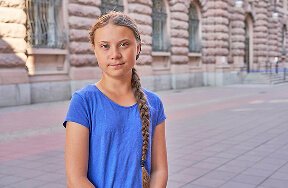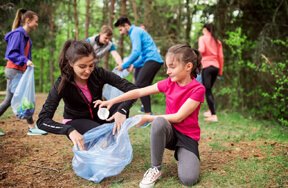People are seeing change all over the world. Arctic sea ice is melting earlier and forming later. Glaciers are disappearing. Heat waves, storms and floods are becoming more extreme. Insects are emerging sooner and flowers are blooming earlier. In some places, birds are laying eggs before they’re expected and bears have stopped hibernating.
So what’s going on? Our planet is getting warmer, and even a small increase in temperature can change our climate. And when our climate changes, we’re all affected.
A Natural Greenhouse
Earth is the only planet we know of that can support life. The reason Earth is different than the rest relies on a number of factors. We get just the right amount of energy from the sun (if we were any closer, we would burn up; if we were any further, we’d freeze). Our atmosphere is a layer of gases surrounding the Earth that absorbs ultra violet radiation and prevents temperatures from rising too high or getting too cold. The greenhouse effect is the process that causes the surface of the Earth to be warmer than it would be if we had no atmosphere. Without these three factors, most like on Earth couldn’t exist.
 The Greenhouse Effect
The Greenhouse Effect
Natural Cycles
Several natural cycles of the Earth keep it and its atmosphere in perfect balance. Carbon is essential to life and the carbon cycle keeps it moving throughout all Earth’s systems. Water is one of the most important things to our survival, and the water cycle keeps it moving around and around our Earth and atmosphere – even through our bodies.
Weather Versus Climate
Weather is what’s happening with the atmosphere that surrounds us. It’s not the same as climate, which refers to the pattern of weather we expect to see in a particular place. The weather is always driven by the sun’s energy, whether it’s warm outside or snowing due to the circulation of warm air to cold places and cold air to warm places by the atmosphere. This, combined with the movement of the oceans and the amount of moisture in the air creates everything from perfect sunny days to terror-filled tornadoes.
Even though the weather changes frequently, the climate of a particular place should always be about the same. In Alaska, for example, there shouldn’t be any tropical-like weather. In California, it shouldn’t snow too much in the winter.
The fact is, while the Earth’s climate has changed many times over millions of years (ice ages, for example, happen naturally every 100,000 years or so), it really shouldn’t be changing much during any one person’s lifetime. We’re still recovering from the last ice age, which is said to have wiped out the dinosaurs. While temperatures do rise gradually over time after an ice age, today our planet’s surface temperatures seem to be rising faster now than they were 100 years ago. And this is what has many people worried.
Balancing Act
Our planet is always changing and its systems are constantly working together to keep a kind of balance. All forms of life, including humans, depend on this balance for their existence.
All living things are connected to each other in ecosystems by food chains and food webs. Plants get energy from the sun. Herbivores (species that don’t eat meat) get energy by eating plants. Carnivores (that eat meat) get energy by eating herbivores. This is how energy flows through all ecosystems – starting from the sun.
When any one part of an ecosystem chain breaks, the survival of the entire system, along with every living thing that depends on it for survival, hangs in the balance. For example, if someone decides to spray a poisonous pesticide on plants to keep bugs from eating them, then lizards may accidentally ingest that poison when they eat the plants and cats may be poisoned, too, when they catch and eat the lizards. With no cats around, the rat population could explode – and rats carry diseases that are even more dangerous for humans.
Another example is when a volcano erupts. If the eruption is very big, it could do a lot of damage besides killing thousands of people. A volcanic eruption spreads huge amounts of ash and gases into the atmosphere and around the globe, which could cause temperatures worldwide to fall. And when temperatures change dramatically like this, it affects crop patterns and could lead to massive food shortages.
Temperature Rising
Whether you believe in global warming or not, the fact is that the 11 hottest years recorded in the last 100 years have all happened after 1995. The world is definitely getting warmer.
When the world’s temperatures get warmer, a few things happen. The water cycle speeds up, causing more rain, droughts, wildfires and extreme heat waves. There will be more greenhouse gases in the air, as the atmosphere reaches capacity of how many gases it can absorb. Arctic ice will melt sooner and faster and won’t be as thick or expensive when it reforms. The oceans will warm and cause sea levels to rise more quickly, which can cause flooding on land and water contamination. Glacier ice will melt.
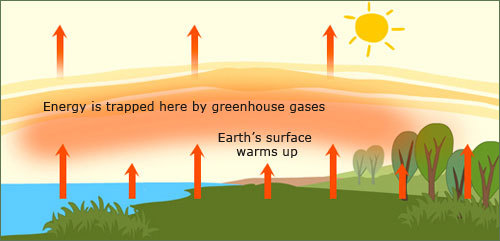
Greenhouse Gases
These gases help keep the world from being too hot or too cold. But the amounts of some greenhouse gases in the atmosphere are increasing, making our planet warmer. Greenhouse gases include water vapor (mostly natural source), carbon dioxide (mostly human source), methane (mostly human source) and nitrous oxide (mostly human source).
Far North & South
The most global warming has been seen in the Earth’s coldest places, like the Arctic, Antarctica, Alaska and parts of Canada, Scandinavia and Russia.
Arctic temperatures are rising twice as fast as anywhere else on Earth. There has been a huge amount of ice loss in the last 20-30 years. While some is natural, global warming seems to be the main culprit. Ice shelves that have been around for tens of thousands of years have collapsed due to lower temperatures, which causes sea levels to rise. Permafrost has started to melt, which results in forests and even towns and cities to crumble as the ground beneath them thaws.
Because the far north and south have very fragile ecosystems, when one part of the chain breaks the effects can be seen almost immediately. As the ice disappears, so are tiny sea creatures called krill are dying – and so are the many fish, birds and whales that eat them. Polar bears spend most of their time on sea ice hunting seals and other sea animals. As the ice melts, the bears’ hunting season is shortened and female bears, with lowered body weights, can’t seem to produce cubs. Warmer summers also mean certain pests’ life cycles are longer than before. For example, the spruce bark beetle, which is only supposed to live for one summer, is now surviving for two. This tiny bug destroys an unimaginable number of trees in Arctic forests – and now it can do it two years in a row instead of just one.
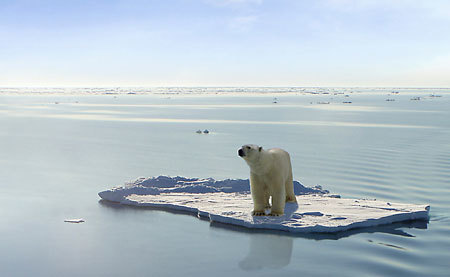 Polar Bear on floating ice
Polar Bear on floating ice
The World Ocean
Most of the Earth’s surface is covered by a single ocean. All forms of life – even those that don’t actually live in the ocean itself – depend on it for survival. For example, our ocean helps control the Earth’s temperature with its currents, by constantly keeping cold and warm water moving. Ocean water dissolves lots of substances, including carbon dioxide gas. All ocean creatures and even sea birds depend on microscopic plankton – tiny plants that take in carbon dioxide to grow – for food and survival.
But when the ocean warms (which it has been), it can’t dissolve as much carbon dioxide, plankton can’t survive and the currents change (which greatly affects the weather and other things on dry land). Also, the sea level rises, so certain islands that are currently above water may actually disappear in the next 100 years.
The effects of global warming on things that live in the ocean are massive. We already talked about plankton, but what about other species? Coral reefs – home to many ecosystems and living creatures – can die as water temperatures rise. Sea turtles depend on beaches to lay their eggs, but many beaches are disappearing thanks to rising sea levels. Whales, who depend on krill who depend on plankton, die. Fish stocks fall, translating into food shortages for humans.
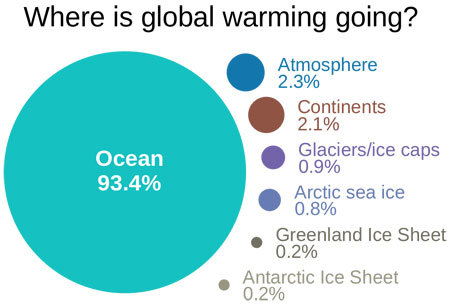 Where is global warming going?
Where is global warming going?
We All Live On Land
What changes are we seeing on land as a result of global warming? We’re seeing longer periods of drought, more wildfires, growing deserts (which can’t support farming), glacier melt and deforestation. In fact, every second a chunk of forest the size of a football field is cut down or burned somewhere in the world.
In terms of living things, the effects of global warming are causing huge changes and disruptions. Plants and insects are moving upward (north) and causing distress to the natural, original ecosystems of those areas. Birds are also moving further north and some are even laying their eggs earlier, which can be a problem when it’s out of sync with insect hatchings (since birds are insects’ main predators). The winter of 2006 was so warm that mountain bears in Spain decided not to hibernate (sleep for the winter).
And what about us humans? How does and will global warming affect us, our lives and our survival as a species? First off, all human needs fresh water to survive. But changing rainfall patterns and melting glaciers will cause severe droughts, during which crops will fail, causing huge food shortages. We can also expect more heat waves. In 2003, Europe experienced such an extreme spell of hot weather that more than 20,000 people died as a direct result of the heat. Also, mass extinction of many other species we depend on for survival will mean big trouble for humanity.
Our Energy Use
There is no doubt that it’s our own fault the world’s temperature is rising and global warming is happening. We depend too much on fossil fuels that release deadly amounts carbon dioxide into the atmosphere. We need to start considering alternative sources of energy quickly, like nuclear, solar and wind. We cut down trees, which use carbon dioxide in their natural life cycles, so less of the poisonous gas can be absorbed naturally.
Humans are high energy consumers. Every day, we each exhale 1 kilogram (2.2 pounds) of carbon dioxide into the air. We keep ourselves warm in cold places by burning huge amounts of fuel. We use tons of energy pumping, cleaning, heating and then disposing of water. The food we eat is a huge source of greenhouse gases: fossil fuels used in fertilizers and farm machinery, food processing, transportation, packing and cooking. Construction requires all kinds of building materials that can only be made with massive amounts of energy. Our major sources of transportation are huge consumers of energy – ships, jets and cars. Electricity isn’t captured magically – it takes the burning of massive amounts of fossil fuel to convert energy into electrical current. And all the “things” in your life – clothes, cell phones, toothbrushes, etc. – are made using energy… and so are the packages all these things come in.
You CAN Help!
The problem seems so big, it may be hard for you to imagine that anything you do can really help at all. But it will. Here are some changes you can make in your life to help prevent global warming:
- Plant trees
- Start a seed bank (keep the seeds of many varieties of plants stored away safely)
- Switch every light in your house to an energy-saving bulb
- Reduce, reuse, recycle
- Wear a sweater instead of turning up the heat in your house
- Wear lighter clothing when it’s hot instead of turning on a fan
- Turn lights, computers and all your chargers off and unplug them when they’re not in use
- Only do full loads of laundry
- Take shorter showers
- Skip the car ride and use your bike, or walk or take the bus
- Don’t buy bottled water; drink tap water, and filter it if you like
- Eat lower on the food chain (less meat) and eat fewer processed foods
Knowledge is power. Change can only happen if all of us read about, listen to and discuss what’s happening in the world today.
Planet Power
If scientists are right, each one of us is at least a little bit responsible for global warming. So each of us has to decide what we’re going to do about it, and what kind of world we want to live in.
Our planet has been around for almost 5 billion years. It’s gone through so many changes during that time – global warming may be the Earth’s next big change.
No matter what changes lie ahead, our planet isn’t going anywhere. And neither are we. But what we do now could have a big effect on what our lives could be like in the near future. This is our planet – let’s make sure in the future it stays as wonderful a place to live in as it is now.
Related Stories:





























